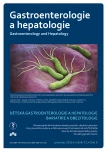Wilson’s disease in childhood – two case reports
Authors:
El-Lababidi N. 1; Houštěk S. 2; Šochman P. 3; Šípek A. 4; Frühauf P. 1
Published in the journal:
Gastroent Hepatol 2018; 72(6): 486-489
Category:
Dětská gastroenterologie a hepatologie: kazuistika
doi:
https://doi.org/10.14735/amgh2018486
Summary
Two unrelated girls aged 5.5 and 8 years were accidentally found to have hepatopathy and hepatomegaly. Various tests for serological, immunological, and metabolic diseases, including assessment of the ceruloplasmin and urinary copper concentrations, yielded negative results. Histological examination of liver biopsies showed varying degrees of steatosis and fibrosis in both girls. The copper concentration in dry liver specimens fulfilled the criteria for Wilson’s disease (WD). Genetic examination identified two pathogenic mutations in the ATP7B gene in both girls. WD was diagnosed, and therapy with chelating agents was initiated, which had good effects. These case reports emphasize that up to 20% of pediatric and adult WD patients have normal ceruloplasmin and urinary copper levels. The new diagnostic and therapeutic recommendations for pediatric WD issued by the European Society of Pediatric Gastroenterology, Hepatology, and Nutrition are summarized.
Key words:
Wilson’s disease – ATP7B gene – copper – ceruloplasmin – D-penicillamine – zinc salts
Submitted: 31. 8. 2018
Accepted: 10. 10. 2018
The authors declare they have no potential conflicts of interest concerning drugs, products, or services used in the study..
The Editorial Board declares that the manuscript met the ICMJE „uniform requirements“ for biomedical papers.
Zdroje
1. Socha P, Janczyk W, Dhawan A et al. Wilson’s disease in children: A position paper by the Hepatology Committee of the European Society for Paediatric Gastroenterology, Hepatology and Nutrition. J. Pediatr Gastroenterol Nutr 2018; 66(2): 334–344. doi: 10.1097/ MPG.0000000000001787.
2. Bandmann O, Weiss KH, Kaler SG. Wilson’s disease and other neurological copper disorders. Lancet Neurol 2015; 14(1): 103–113. doi: 10.1016/ S1474-4422(14)70190-5.
3. Coffey AJ, Durkie M, Hague S et al. A genetic study of Wilson’s disease in the United Kingdom. Brain 2013; 136(Pt5): 1476–1487. doi: 10.1093/ brain/ awt035.
4. Chang IJ, Hahn SH. The genetics of Wilson disease. Handb Clin Neurol 2017; 142: 19–34. doi: 10.1016/ B978-0-444-63625-6.00003-3.
5. Dzieżyc K, Litwin T, Chabik G et al. Families with Wilson’s disease in subsequent generations: clinical and genetic analysis. Mov Disord 2014; 29(14): 1828–1832. doi: 10.1002/ mds.26057.
6. Lin LJ, Wang DX, Ding NN et al. Comprehensive analysis on clinical features of Wilson’s disease: an experience over 28 years with 133 cases. Neurol Res 2014; 36(2): 157–163. doi: 10.1179/ 1743132813Y.0000000262.
7. Favre E, Lion-François L, Canton M et al. Cognitive abilities of children with neurological and liver forms of Wilson disease. J Pediatr Gastroenterol Nutr 2017; 64(3): 436–439. doi: 10.1097/ MPG.0000000000001346.
8. Merle U, Schaefer M, Ferenci P et al. Clinical presentation, diagnosis and long-term outcome of Wilson’s disease: a cohort study. Gut 2007; 56(1): 115–120.
9. Walshe JM. The acute hemolytic syndrome in Wilson’s disease – a review of 22 cases. QJM 2013; 106(11): 1003–1008. doi: 10.1093/ qjmed/ hct137.
10. Mak CM, Lam CW, Tam S. Diagnostic accuracy of serum ceruloplasmin in Wilson disease: determination of sensitivity and specificity by ROC curve analysis among ATP7B-genotyped subjects. Clin Chem 2008; 54(8): 1356–1362. doi: 10.1373/ clinchem.2008.103432.
11. Nicastro E, Ranucci G, Vajro P et al. Re-evaluation of the diagnostic criteria for Wilson disease in children with mild liver disease. Hepatology 2010; 52(6): 1948–1956. doi: 10.1002/ hep.23910.
12. Johncilla M, Mitchell KA. Pathology of the liver in copper overload. Semin Liver Dis 2011; 31(3): 239–244. doi: 10.1055/ s-0031-1286055.
13. European Association for Study of Liver. EASL Clinical practice guidelines: Wilson’s disease. J Hepatol 2012; 56(3): 671–685. doi: 10.1016/ j.jhep.2011.11.007.
14. Weiss KH, Gotthardt DN, Klemm D et al. Zinc monotherapy is not as effective as chelating agents in treatment of Wilson disease. Gastroenterology 2011; 140(4): 1189–1198.e1. doi: 10.1053/ j.gastro.2010.12.034.
15. Ranucci G, Di Dato F, Spagnuolo MI et al. Zinc monotherapy is effective in Wilson’s disease patients with mild liver disease diagnosed in childhood: a retrospective study. Orphanet J Rare Dis 2014; 9: 41. doi: 10.1186/ 1750-1172-9-41
Štítky
Dětská gastroenterologie Gastroenterologie a hepatologie Chirurgie všeobecnáČlánek vyšel v časopise
Gastroenterologie a hepatologie

2018 Číslo 6
- Metamizol jako analgetikum první volby: kdy, pro koho, jak a proč?
- Horní limit denní dávky vitaminu D: Jaké množství je ještě bezpečné?
- Neodolpasse je bezpečný přípravek v krátkodobé léčbě bolesti
- Ferinject: správně indikovat, správně podat, správně vykázat
Nejčtenější v tomto čísle
- Meckelův divertikl jako příčina náhlé příhody břišní
- Hepatopatie jako první projev systémové AL amyloidózy
- Wilsonova choroba v dětském věku – dvě kazuistiky
- Novinky ve farmakoterapii obezity
